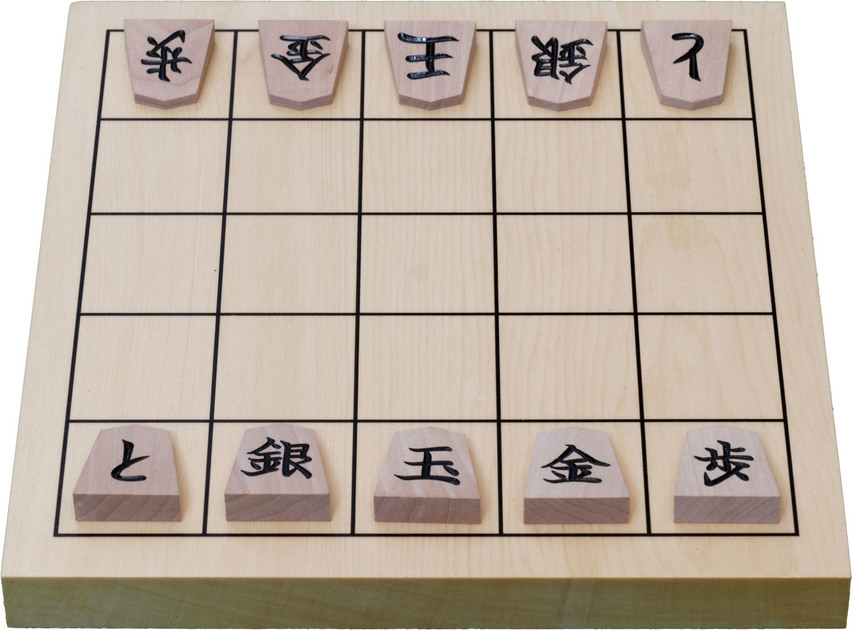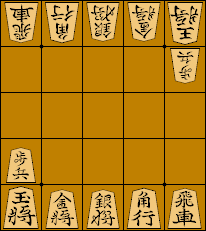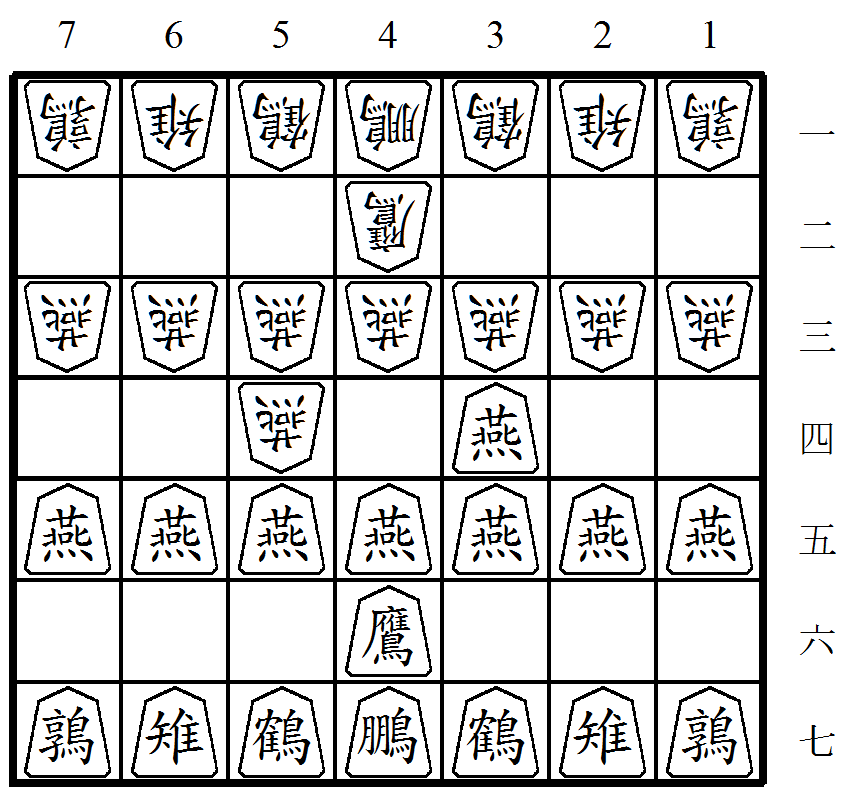|
Yari Shogi
Yari shogi (槍将棋 ''yari shōgi'', spear chess, where 'spear' is another name for the lance piece) is a modern variant of shogi (Japanese chess); however, it is not Japanese. It was invented in 1981 by Christian Freeling of the Netherlands. This game accentuates shogi’s intrinsically forward range of direction by giving most of the pieces the ability to move any number of free squares orthogonally forward like a shogi lance. The opposite is true of promoted pieces which can move backward with the same power. Rules of the game Objective The objective of the game is to capture your opponent's general. Game equipment Two players, Black and White (or 先手 ''sente'' and 後手 ''gote''), play on a board ruled into a grid of 9 ''ranks'' (rows) by 7 ''files'' (columns). The squares are undifferentiated by markings or color. Each player has a set of 14 wedge-shaped pieces, of slightly different sizes. From largest to smallest (most to least powerful) they are: * 1 general * 2 y ... [...More Info...] [...Related Items...] OR: [Wikipedia] [Google] [Baidu] |
Shogi Variant
A shogi variant is a game related to or derived from shogi (Japanese chess). Many shogi variants have been developed over the centuries, ranging from some of the largest chess-type games ever played to some of the smallest. A few of these variants are still regularly played, though none are as popular as shogi itself. The drop rule, often considered the most notable feature of shogi, is absent from most shogi variants, which therefore play more like other forms of chess, with the board becoming less crowded as pieces are exchanged. This is especially true for variants larger than shogi itself − in fact, the largest well-known variant that features the drop rule is the 11×11 game wa shogi. Predecessors of modern shogi Some form of chess had almost certainly reached Japan by the 9th century, if not earlier, but the earliest surviving Japanese description of the rules of chess dates from the early 12th century, during the Heian period. Unfortunately, this description does not ... [...More Info...] [...Related Items...] OR: [Wikipedia] [Google] [Baidu] |
Algebraic Chess Notation
Algebraic notation (or AN) is the standard method for recording and describing the moves in a game of chess. It is based on a system of coordinates to uniquely identify each square on the chessboard. It is used by most books, magazines, and newspapers. In English-speaking countries, the parallel method of descriptive notation was generally used in chess publications until about 1980. A few players still use descriptive notation, but it is no longer recognized by FIDE, the international chess governing body. Algebraic notation exists in various forms and languages and is based on a system developed by Philipp Stamma. Stamma used the modern names of the squares, but he used p for pawn moves and the original of a piece (a through h) instead of the initial letter of the piece name. The term "algebraic notation" may be considered a misnomer, as the system is unrelated to algebra. Other terms such as "standard notation" and "coordinate notation" have been proposed, but the traditional ... [...More Info...] [...Related Items...] OR: [Wikipedia] [Google] [Baidu] |
Dragonfly (chess Variant)
Dragonfly (also known as Shuttle Chess or Bird Chess) is a chess variant invented by Christian Freeling in 1983. There are no queens, and a captured bishop, knight, or rook becomes the property of the capturer, who may play it as their own on a turn to any open square. The board is 7×7 squares, or alternatively a 61-cell hexagon with two additional pawns per side. The game is an offshoot and simplification of a Freeling game named Loonybird (or Dragon Chess). Still, "Play is complex and interesting. Draws are rare too." Game rules The standard rules of chess apply, including winning by checkmate. But Dragonfly follows these special rules: * A bishop, knight, or rook that is captured enters the capturing player's pieces in hand in their own color. As a move, a player may drop any one of the pieces they have in hand on any open square (if the move is otherwise legal). Captured pawns do not go in hand and are instead removed from the game. * Pawns do not have an initial dou ... [...More Info...] [...Related Items...] OR: [Wikipedia] [Google] [Baidu] |
Cannon Shogi
A shogi variant is a game related to or derived from shogi (Japanese chess). Many shogi variants have been developed over the centuries, ranging from some of the largest chess-type games ever played to some of the smallest. A few of these variants are still regularly played, though none are as popular as shogi itself. The drop rule, often considered the most notable feature of shogi, is absent from most shogi variants, which therefore play more like other forms of chess, with the board becoming less crowded as pieces are exchanged. This is especially true for variants larger than shogi itself − in fact, the largest well-known variant that features the drop rule is the 11×11 game wa shogi. Predecessors of modern shogi Some form of chess had almost certainly reached Japan by the 9th century, if not earlier, but the earliest surviving Japanese description of the rules of chess dates from the early 12th century, during the Heian period. Unfortunately, this description does not ... [...More Info...] [...Related Items...] OR: [Wikipedia] [Google] [Baidu] |
Kyoto Shogi
is a modern variant of shogi (Japanese chess). It was invented by Tamiya Katsuya c. 1976. Kyoto shogi is played like standard shogi, but with a reduced number of pieces on a 5×5 board. However, the pieces alternately promote and demote with every move, and the promotion values are entirely different from standard shogi. Rules of the game Game equipment Two players play on a board ruled into a grid of 5 ''ranks'' (rows) by 5 ''files'' (columns). The squares are undifferentiated by marking or color. Each player has a set of 5 wedge-shaped pieces, of slightly different sizes. From largest to smallest (most to least powerful) they are: * 1 king * 1 gold general * 1 silver general * 1 tokin * 1 pawn The names of the pieces combine their promoted and unpromoted values, and are puns in Japanese for words with the same pronunciations but different kanji. For example, the lance/tokin is homonymous with the name of the city 京都 Kyoto, and provides the name of the game. Se ... [...More Info...] [...Related Items...] OR: [Wikipedia] [Google] [Baidu] |
Microshogi
Microshogi (五分摩訶将棋 ''gofun maka shōgi'' "5-minute (scarlet) poppy chess") is a modern variant of shogi (Japanese chess), with very different rules for promotion, and demotion. Kerry Handscomb of NOSTNOST (kNights of the Square Table), a (now defunct) correspondence game club formed in 1960 by Bob Lauzon and Jim France, enjoyed several hundred active members. gave it this English name. Although not confirmed, he credits its invention to the late Oyama Yasuharu, a top level shogi player. The game was invented before 1982. Equipment Two players play on a board ruled into a grid of 5 ranks (rows) by 4 files (columns). The squares are undifferentiated by marking or color. Each player has a set of 5 wedge-shaped pieces. The pieces are of slightly different sizes. From largest to smallest (or most to least powerful) they are: *1 king *1 bishop *1 gold general *1 silver general *1 pawn Game rules The game is identical to standard shogi with the following exceptions. Setu ... [...More Info...] [...Related Items...] OR: [Wikipedia] [Google] [Baidu] |
Judkins Shogi
Judkins shogi (ジャドケンス将棋 ''Jadokensu shōgi'' "Judkins chess") is a modern variant of shogi (Japanese chess), however it is not Japanese. Credit for its invention has been given to Paul Judkins of Norwich, UK, prior to April 1998. Rules of the game Objective The objective of the game is to capture your opponent's king. Game equipment Two players, Black and White (or 先手 ''sente'' and 後手 ''gote''), play on a board ruled into a grid of 6 ''ranks'' (rows) by 6 ''files'' (columns). The squares are undifferentiated by marking or color. Each player has a set of 7 wedge-shaped pieces, of slightly different sizes. From largest to smallest (most to least powerful) they are: * 1 king * 1 rook * 1 bishop * 1 gold general * 1 silver general * 1 knight * 1 pawn Most of the English-language names are chosen to correspond to rough equivalents in Western chess, rather than as translations of the Japanese names. Each piece has its name in the form of two kanji written ... [...More Info...] [...Related Items...] OR: [Wikipedia] [Google] [Baidu] |
Minishogi
Minishogi (5五将棋 ''gogo shōgi'' "5V chess" or "5×5 chess") is a modern variant of shogi (Japanese chess). The game was invented (or rediscovered) around 1970 by Shigenobu Kusumoto of Osaka, Japan. The rules are nearly identical to those of standard shogi, with the exception that it is played on a 5x5 board with a reduced number of pieces, and each player's promotion zone consists only of the rank farthest from the player. Rules of the game Objective Like in standard shogi, each player aims to checkmate the opponent's king. Game equipment Two players play on a board ruled into a grid of five ranks (rows) by five files (columns). The squares are undifferentiated by marking or color. Each player begins with a set of 6 wedge-shaped pieces; these are: *1 king *1 rook *1 bishop *1 gold general *1 silver general *1 pawn Their movements are identical to those of their namesakes in standard shogi. Setup Each player places their pieces in the positions shown below, point ... [...More Info...] [...Related Items...] OR: [Wikipedia] [Google] [Baidu] |
Tori Shogi
Tori shōgi (禽将棋 or 鳥将棋, 'bird chess') is a variant of shogi (Japanese chess), which was invented by Toyota Genryu in 1799 despite being traditionally attributed to his master Ōhashi Sōei. It was first published in 1828 and again in 1833. The game is played on a 7×7 board and uses the drop rule; it is the only traditional shogi variant, possibly besides wa shogi, to do so. This is one of the more popular shogi variants. There were tournaments in London and Royston in the 1990s and early 2000s. Rules of the game Objective The objective of the game is to capture your opponent's phoenix. Game equipment Two players, Black and White (or 先手 ''sente'' and 後手 ''gote),'' play on a board ruled into a grid of 7 ''ranks'' (rows) by 7 ''files'' (columns). The squares are undifferentiated by marking or color. Each player has a set of 16 wedge-shaped pieces, of slightly different sizes. From largest to smallest (or most to least powerful) they are: * 1 phoenix * 1 f ... [...More Info...] [...Related Items...] OR: [Wikipedia] [Google] [Baidu] |
Ellipsis
The ellipsis (, also known informally as dot dot dot) is a series of dots that indicates an intentional omission of a word, sentence, or whole section from a text without altering its original meaning. The plural is ellipses. The term originates from the grc, ἔλλειψις, meaning 'leave out'. Opinions differ as to how to render ellipses in printed material. According to ''The Chicago Manual of Style'', it should consist of three periods, each separated from its neighbor by a non-breaking space: . According to the ''AP Stylebook'', the periods should be rendered with no space between them: . A third option is to use the Unicode character U+2026 . Background The ellipsis is also called a suspension point, points of ellipsis, periods of ellipsis, or (colloquially) "dot-dot-dot".. According to Toner it is difficult to establish when the "dot dot dot" phrase was first used. There is an early instance, which is perhaps the first in a piece of fiction, in Virginia Woolf's ... [...More Info...] [...Related Items...] OR: [Wikipedia] [Google] [Baidu] |
Japanese Numerals
The Japanese numerals are the number names used in Japanese. In writing, they are the same as the Chinese numerals, and large numbers follow the Chinese style of grouping by 10,000. Two pronunciations are used: the Sino-Japanese (on'yomi) readings of the Chinese characters and the Japanese yamato kotoba (native words, kun'yomi readings). Basic numbering in Japanese There are two ways of writing the numbers in Japanese: in Arabic numerals (1, 2, 3) or in Chinese numerals (, , ). The Arabic numerals are more often used in horizontal writing, and the Chinese numerals are more common in vertical writing. Most numbers have two readings, one derived from Chinese used for cardinal numbers (On reading) and a native Japanese reading (Kun reading) used somewhat less formally for numbers up to 10. In some cases (listed below) the Japanese reading is generally preferred for all uses. Archaic readings are marked with †. * The special reading 〇 ''maru'' (which means "round" or "circle ... [...More Info...] [...Related Items...] OR: [Wikipedia] [Google] [Baidu] |
No Contest (boxing)
No contest (abbreviated "NC") is a technical term used in some combat sports to describe a fight that ends for reasons outside the fighters' hands, without a winner or loser. The concept carried over to professional wrestling, where it is far more common, usually scripted to further a feud, generate heat and/or protect a push. Boxing In the 19th and early parts of the 20th century, many countries (and some parts of the United States) officially banned boxing, and occasionally the police would step in to shut down the bouts (which, although unlawful, were still sanctioned by regional boxing commissions). Since boxing is now lawful virtually anywhere in the world, the number of fights called no contest has decreased dramatically since the beginning of the 20th century. Referees were also known to stop bouts during this period when they felt bouts were too slow due to lack of aggression from one or both boxers. In the modern game, the various rules that dictate whether a fight should ... [...More Info...] [...Related Items...] OR: [Wikipedia] [Google] [Baidu] |



.jpg)